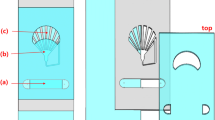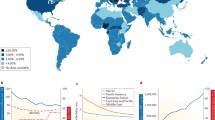Abstract
A home-use device that allows rapid and quantitative sperm quality analysis is desirable but not yet fully realized. To aid this effort, this article presents a microfluidic device capable of quantifying sperm quality in terms of two critical fertility-related parameters—motile sperm concentration and motility. The microdevice produces flow field for sperms to swim against, and sperms that overcame the flow within a specified time are propelled along in a separate channel and counted via resistive pulse technique. Data are compared to two control methods clinically utilized for sperm quality exam—hemocytometer and the sperm quality analyzer. Results reveal the numbers of pulses generated by passage of sperms correlates strongly with the two control methods: pulse number from 0 to 335 corresponds to progressively motile sperm concentrations from 0 to 19 × 106/ml (hemocytometer) and Sperm Motility Index from 0 to 204 (sperm quality analyzer). The microdevice should be applicable to facilitate self-assessment of sperm quality at home.







Similar content being viewed by others
References
Beebe DJ, Mensing GA, Walker GM (2002) Physics and applications of microfluidics in biology. Annu Rev Biomed Eng 4:261–286
Chen CY, Tu TY, Chen CH, Jong DS, Wo AM (2009) Patch clamping on plane glass—fabrication of hourglass aperture and high-yield ion channel recording. Lab Chip 9:2370–2380
Cho BS, Schuster TG, Zhu XY, Chang D, Smith GD, Takayama S (2003) Passively driven integrated microfluidic system for separation of motile sperm. Anal Chem 75:1671–1675
DeBlois RW, Bean CP (1970) Counting and sizing of submicron particles by the resistive pulse technique. Rev Sci Instrum 41:909–916
Engelmann U, Krassnigg F, Schatz H, Schill WB (1988) Separation of human X-spermatozoa and Y-spermatozoa by free-flow electrophoresis. Gamete Res 19:151–159
Horowitz P, Hill W (1989) The art of electronics. Press Syndicate of the University of Cambridge, New York
Horsman KM, Barker SLR, Ferrance JP, Forrest KA, Koen KA, Landers JP (2005) Separation of sperm and epithelial cells in a microfabricated device: potential application to forensic analysis of sexual assault evidence. Anal Chem 77:742–749
Ionescu-Zanetti C, Shaw RM, Seo JG, Jan YN, Jan LY, Lee LP (2005) Mammalian electrophysiology on a microfluidic platform. Proc Natl Acad Sci USA 102:9112–9117
Koyama S, Amarie D, Soini HA, Novotny MV, Jacobson SC (2006) Chemotaxis assays of mouse sperm on microfluidic devices. Anal Chem 78:3354–3359
Kricka LJ, Nozaki O, Heyner S, Garside WT, Wilding P (1993) Application of a microfabricated device for evaluating sperm function. Clin Chem 39:1944–1947
Kricka LJ, Faro I, Heyner S et al (1997) Micromachined analytical devices: microchips for semen testing. J Pharm Biomed Anal 15:1443–1447
Lee BS, Lee JN, Park JM et al (2009) A fully automated immunoassay from whole blood on a disc. Lab on a Chip 9:1548–1555
Li XH, Klemic KG, Reed MA, Sigworth FJ (2006) Microfluidic system for planar patch clamp electrode arrays. Nano Lett 6:815–819
Lin CM, Lai YS, Liu HP, Chen CY, Wo AM (2008) Trapping of bioparticles via microvortices in a microfluidic device for bioassay applications. Anal Chem 80:8937–8945
Lopez-Garcia MDC, Monson RL, Haubert K, Wheeler MB, Beebe DJ (2008) Sperm motion in a microfluidic fertilization device. Biomed Microdevices 10:709–718
Manaresi N, Romani A, Medoro G et al (2003) A CMOS chip for individual cell manipulation and detection. IEEE J Solid-State Circuits 38:2297–2305
Martinez C, Mar C, Azcarate M, Pascual P, Aritzeta JM, Lopez-Urrutia A (2000) Sperm motility index: a quick screening parameter from sperm quality analyser-IIB to rule out oligo- and asthenozoospermia in male fertility study. Hum Reprod 15:1727–1733
McCormack MC, McCallum S, Behr B (2006) A novel microfluidic device for male subfertility screening. J Urol 175:2223–2227
Schuster TG, Cho BS, Keller LM, Takayama S, Smith GD (2003) Isolation of motile spermatozoa from semen samples using microfluidics. Reprod BioMed Online 7:75–81
Seo DB, Agca Y, Feng ZC, Critser JK (2007) Development of sorting, aligning, and orienting motile sperm using microfluidic device operated by hydrostatic pressure. Microfluid Nanofluid 3:561–570
Shao B, Shi LZ, Nascimento JM et al (2007) High-throughput sorting and analysis of human sperm with a ring-shaped laser trap. Biomed Microdevices 9:361–369
Sia SK, Whitesides GM (2003) Microfluidic devices fabricated in poly(dimethylsiloxane) for biological studies. Electrophoresis 24:3563–3576
Smith GD, Takayama S (2007) Gamete and embryo isolation and culture with microfluidics. Theriogenology 68:S190–S195
Suh R, Takayama S, Smith GD (2005) Microfluidic applications for andrology. J Androl 26:664–670
Suh RS, Zhu XY, Phadke N, Ohl DA, Takayama S, Smith GD (2006) IVF within microfluidic channels requires lower total numbers and lower concentrations of sperm. Hum Reprod 21:477–483
Toh YC, Lim TC, Tai D, Xiao G, Noort DV, Yu H (2009) A microfluidic 3D hepatocyte chip for drug toxicity testing. Lab on a Chip 9:2026–2035
Wheeler MB, Walters EM, Beebe DJ (2007) Toward culture of single gametes: the development of microfluidic platforms for assisted reproduction. Theriogenology 68:S178–S189
Whitesides GM, Ostuni E, Takayama S, Jiang XY, Ingber DE (2001) Soft lithography in biology and biochemistry. Annu Rev Biomed Eng 3:335–373
Wu JM, Chung YK, Belford KJ, Smith GD, Takayama S, Lahann J (2006) A surface-modified sperm sorting device with long-term stability. Biomed Microdevices 8:99–107
Acknowledgments
Funding from the National Science Council (Grants NSC98-2120-M-002-009 and NSC94-2212-E-002-054) is gratefully acknowledged. Professors Ju-Ton Hsieh and Hong-Chiang Chang in the Department of Urology, National Taiwan University Hospital are acknowledged for their helpful discussion throughout this study. Miss M.M. Liu in the Department of Urology, National Taiwan University Hospital provided invaluable assistance on the operation of the Sperm Quality Analyzer.
Author information
Authors and Affiliations
Corresponding author
Rights and permissions
About this article
Cite this article
Chen, YA., Huang, ZW., Tsai, FS. et al. Analysis of sperm concentration and motility in a microfluidic device. Microfluid Nanofluid 10, 59–67 (2011). https://doi.org/10.1007/s10404-010-0646-8
Received:
Accepted:
Published:
Issue Date:
DOI: https://doi.org/10.1007/s10404-010-0646-8




